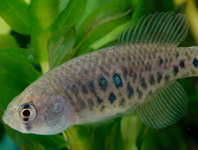Abstract
The troglobitic darkling beetle Foranotum perforatum gen. et sp. nov. from a cave in Southern Zagros Mountains (Iran) is described. This new taxon belongs to the family Tenebrionidae based on the following combination of characters: tarsal formula 5-5-4, antennal insertions concealed from above, antennae 11-segmented, mesocoxal cavities laterally closed by meso- and metaventrite. It is close to Kuhitangia kryzhanovskii Medvedev, 1962 by sharing a similar structure of procoxa (open cavities), labrum (reduced tormal arms) and prothorax (perforating holes on lateral sides of disc). Based on a comprehensive character analysis the subfamily Kuhitangiinae (type genus Kuhitangia Medvedev, 1962) is reestablished. Kuhitangiinae belongs to the pimelioid branch of the family Tenebrionidae based on open mouthparts (mentum small, exposing most of maxillae), mesocoxae externally closed by meso- and metaventrite, metacoxae externally narrowly closed by metaventrite and first abdominal ventrite, tentyrioid structure of abdominal ventrites (absence of membranes between abdominal ventrites 3–5) and absence of defensive glands. The subfamily Kuhitangiinae is divided into following two tribes: Kuhitangiini with a single species Kuhitangia kryzhanovskii Medvedev, 1962 and Foranotini trib. n. with Foranotum perforatum sp. nov. The new tribe differs from Kuhitangiini by the presence of trochanters and epipleura, structure of pronotum, abdominal ventrites and sculpture of meso- and metaventrites.
References
Aalbu, R.L., Kanda, K. & Smith, A.D. (2017) Reinstatement of Eschatoporiini Blaisdell, 1906, a unique tribe of blind cavernicolous Tenebrionidae from California, with a new species from Napa County (Coleoptera, Tenebrionidae, Lagriinae). ZooKeys, 688, 135–149.
https://doi.org/10.3897/zookeys.688.13575Bouchard, P., Lawrence, J.F., Davies, A.E. & Newton, A.F. (2005) Synoptic classification of the world Tenebrionidae (Insecta: Coleoptera) with a review of family-group names. Annales zoologici, 55 (4), 499–530.
Doyen, J.T. (1972) Familial and subfamilial classification of the Tenebrionoidea (Coleoptera) and a revised generic classification of the Coniontini (Tentyriidae). Quaestiones entomologicae, 8, 357–376.
Doyen, J.T. & Lawrence, J.F. (1979) Relationships and higher classification of some Tenebrionidae and Zopheridae (Coleoptera). Systematic Entomology, 4, 333–337.
https://doi.org/10.1111/j.1365-3113.1979.tb00619.xDoyen, J.T. & Tschinkel, W.R. (1982) Phenetic and cladistic relationships among tenebrionid beetles (Coleoptera). Systematic Entomology, 7, 127–183.
https://doi.org/10.1111/j.1365-3113.1982.tb00129.xIwan, D. & Kamiński, M. (2016) Toward a natural classification of opatrine darkling beetles: comparative study of female terminalia. Zoomorphology, 135 (4), 453–485.
https://doi.org/10.1007/s00435-016-0328-5Kanda, K (2016) Grabulax gen. nov. darlingtoni sp. nov. (Tenebrionidae: Lagriinae: Laenini) from Colombia, with re-evalution of New World Laenini. Annales Zoologici, 66, 557–562.
https://doi.org/10.3161/00034541ANZ2016.66.4.007Kryzhanovsky, O.L. (1965) Composition and origin of terrestrial fauna of Middle Asia (based on material of beetles). Nauka, Moscow-Leningrad, 419 pp. [in Russian]
Matthews, E.G. & Bouchard, P. (2008) Tenebrionid Beetles of Australia: Descriptions of Tribes, Keys to Genera, Catalogue of Species. Australian Biological Resources Study, Canberra. 410 pp.
Matthews, E.G., Lawrence, J.F., Bouchard, P., Steiner, W.E., Ślipiński, Jr. & Ślipiński, S.A. (2010) 11.14. Tenebrionidae Latreille, 1802. In: Leschen, R.A.B, Beutel, R.G. & Lawrence, J.F. (Eds.), Handbook of zoology. Arthropoda: Insecta. Part 38. Coleoptera, beetles. Vol. 2. Morphology and systematics (Elateroidea, Bostrichiformia, Cucujiformia partim). Walter de Gruyter, Berlin, pp. 574–659.
Medvedev, G.S. (1962) A new subfamily of darkling beetles (Coleoptera, Tenebrionidae) from Turkmenia. Zoologicheskii Zhurnal, 41, 1184–1189.
Medvedev, G.S. (1977) Taxonomic significance of antennal sensilla of darkling beetles (Coleoptera, Tenebrionidae). In: Medvedev, G.S. (Ed.), Trudy vsesoyuznogo entomologisheskogo obshchestva. Vol. 58. Morphological bases of the systematics of insects. Nauka, Leningrad, pp. 61–86. [in Russian]
Medvedev, G.S. & Nepesova, M.G. (1985) Key to the darkling beetles of Turkmenistan. Ylym, Ashkhabad. 180 pp. [in Russian]
Tahami, M. S., Merkl, O. & Sadeghi, S. (2016) Leptodes of Iran, with Description of Six New Cavernicolous Species (Coleoptera: Tenebrionidae: Pimeliinae: Leptodini). Annales Zoologici, 66 (4), 589–606.
https://doi.org/10.3161/00034541ANZ2016.66.4.012Watt, J.C. (1974) A revised subfamily classification of Tenebrionidae (Coleoptera). New Zealand Journal of Zoology, 1, 381–452.
https://doi.org/10.1080/03014223.1974.9517846

